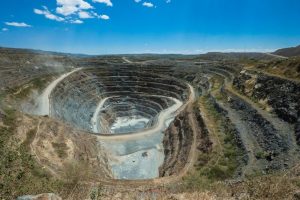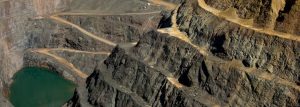In the beautiful Johannesburg exists mountains. Mountains of sandy, dirty, geometric and a glittering landscape that can be beautifully captured from an aerial view. The dust is stirred up by the wind and is blown away to the roads, homes and children play areas. Of course in the poorest areas around. But this beautiful scenery that is worth a few thousand likes on social media is actually huge piles of waste from the country’s 130-year-old gold industry. This contains heavy metals like lead as well as radioactive waste. The effects include neurological disorders. Wastewater pollution is as a result of gold mining. It is because of this reason that Acacia mining in Tanzania has received a hefty fine.

Acacia mining, majorly owned by Barrick Gold has been fined Tsh 5.6 billion equivalent to 2.4 million dollars for alleged pollution at its North Mara mine. Acacia confirmed that the mine would be issued with an EPO relating to alleged historical breaches of environmental regulations in Tanzania. North Mara mine which is a combination of both open pit and underground mining has seen mining activities around the area result in wastewater pollution. This begs the question as to whether sustainable gold mining can be achieved without affecting the lives of the people living around the mines.
Gold mining offers employment and harbours other benefits along with it but Mining is an inherently destructive industry, and the mining effects of even a single operation can have a severe impact on the environment, wildlife and the lives of those that live nearby. Although there are some regulations in place that are intended to minimize the damage, they are not clearly stipulated on how mining and wildlife can co-exist in harmony. This is even worse in cases where regulations are difficult to enforce.
The mining industry has the potential to disrupt ecosystems and wipe out wildlife populations in several different ways. Wondering how it can lead to habitat loss?
Mining can lead to the destruction of habitats in surrounding areas. The process begins with deforestation. This is done so as to clear the land above the mine in a bid to see the workers do their work. Sadly, most mining companies are more concerned with wealth generation as opposed to the concern of forest destruction and its effects. With deforestation comes severe effects.
These effects vary from different species such as the birds, animals and creatures who solely depend on trees and plants for food and shelter. When trees are cut down, these animals lose their homes or the resilient ones starve to death. Plants that rely on trees for shade from the harsh climatic change due to global warming. Deforestation affects them and hinders their growth and production rate.
Some mining methods include the use of explosives which cause further destruction of mountain tops. Moreover, the toxic minerals and chemicals released to go to the streams, rivers and water bodies causing harm to existing marine species due to water contamination.
Basic mining levels require clearing of trees that holds the soil up in place. This process disturbs the ground seeing most soils wash into waterways. The sediment, though not poisonous can cause a disruption on the delicate balance of the aquatic ecosystem by changing and even altering the shape of the river.
Mining can also lead to the shrinking of water tables. Water often seeps into areas that contain coal and other valuable products. For effective working of the mine workers, this water is pumped out of the mine. Aside from the pollution that comes with it, water loss on the ground is experienced. Some mines have to collect water for use as a dust suppressant. This puts more strain on the local water supply.
Residents near the mines who depend on wells for their water supply can also get affected. They are forced to drill deeper so as to have access to water. When water loss from mining is combined with another large source of strain on supply, the results include a shortage and ultimately destruction of ecosystems.
Through the mining process, fossil fuels are extracted from the ground. These fossil fuels can be used to power up mining machinery. Although useful, they emit greenhouse gases into the air contributing o harsh climatic conditions.
Many mines produce methane as a waste product. Methane is a relatively potent greenhouse gas; even a small amount of it can gradually worsen climate change. Coal mines are responsible for approximately six percent of the methane that is released due to human activities.
Abandoning the mines does not solve the problem as all mines are temporal. This is because, despite mines remaining active for many years, they will eventually run out of minerals cease operations. But the effects on Humans, the environment and wildlife species will continue regardless.

Backfilling of underground mines can serve as a solution to this problem but not all operators would embrace it as the process is very expensive.
Failure to backfill a mine leads to subsidence- collapsing of an abandoned mine. This frustrates any efforts intended to reestablish a healthy ecosystem and later rendered uselessly. The problem is heightened if there were any contaminants left on the site since their removal after collapsing of mine proves to be difficult. In order to see nature, recover, waste should be eliminated and the mine duly filled afterwards.
Mining is not about to stop. It has made countries like South Africa rich and even brought about controversies like the fake gold scam witnessed in Kenya. What should be done is to reduce the negative impacts on the environment and wildlife.
Various methods can be implemented so as to shun and regulate the environmental impacts of mining. Illegal mines should be shut as well as investing in the development of sustainable mining technology. Backfilling and proper waste clean-up should be encompassed in the regulations so as to avoid mine collapses and environmental impacts of the waste produced during the mining process.

Safety of the people living around the mines should be ensured hence more emphasis laid on responsible mining. After the gold is turned to a rare beautiful image, it is sold to the ‘rich’ in the community while the ‘mine dwellers’ are left grappling the effects of the whole process. And the environment, damaged. For there to be a sustainable future, the environment, human beings and wildlife should co-exist in harmony. The move by the Tanzanian government could not have come at a better time.
Related article https://africasustainabilitymatters.com/tanzania-fines-acacia-mining-2-4mn-over-alleged-pollution/



